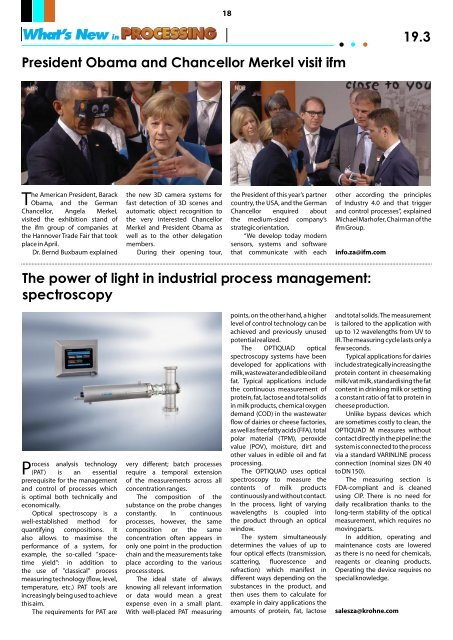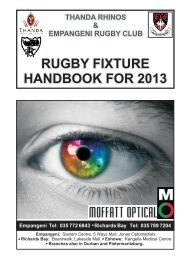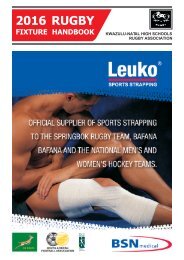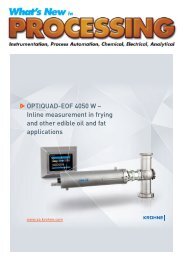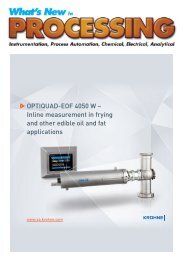WNIP May June 19.3 Digital
Wnip may june 19 3 digital
Wnip may june 19 3 digital
You also want an ePaper? Increase the reach of your titles
YUMPU automatically turns print PDFs into web optimized ePapers that Google loves.
18<br />
<strong>19.3</strong><br />
President Obama and Chancellor Merkel visit ifm<br />
The American President, Barack<br />
Obama, and the German<br />
Chancellor, Angela Merkel,<br />
visited the exhibition stand of<br />
the ifm group of companies at<br />
the Hannover Trade Fair that took<br />
place in April.<br />
Dr. Bernd Buxbaum explained<br />
the new 3D camera systems for<br />
fast detection of 3D scenes and<br />
automatic object recognition to<br />
the very interested Chancellor<br />
Merkel and President Obama as<br />
well as to the other delegation<br />
members.<br />
During their opening tour,<br />
the President of this year’s partner<br />
country, the USA, and the German<br />
Chancellor enquired about<br />
the medium-sized company’s<br />
strategic orientation.<br />
“We develop today modern<br />
sensors, systems and software<br />
that communicate with each<br />
other according the principles<br />
of Industry 4.0 and that trigger<br />
and control processes”, explained<br />
Michael Marhofer, Chairman of the<br />
ifm Group.<br />
info.za@ifm.com<br />
The power of light in industrial process management:<br />
spectroscopy<br />
Process analysis technology<br />
(PAT) is an essential<br />
prerequisite for the management<br />
and control of processes which<br />
is optimal both technically and<br />
economically.<br />
Optical spectroscopy is a<br />
well-established method for<br />
quantifying compositions. It<br />
also allows to maximise the<br />
performance of a system, for<br />
example, the so-called "spacetime<br />
yield": in addition to<br />
the use of "classical" process<br />
measuring technology (flow, level,<br />
temperature, etc.) PAT tools are<br />
increasingly being used to achieve<br />
this aim.<br />
The requirements for PAT are<br />
very different; batch processes<br />
require a temporal extension<br />
of the measurements across all<br />
concentration ranges.<br />
The composition of the<br />
substance on the probe changes<br />
constantly. In continuous<br />
processes, however, the same<br />
composition or the same<br />
concentration often appears in<br />
only one point in the production<br />
chain and the measurements take<br />
place according to the various<br />
process steps.<br />
The ideal state of always<br />
knowing all relevant information<br />
or data would mean a great<br />
expense even in a small plant.<br />
With well-placed PAT measuring<br />
points, on the other hand, a higher<br />
level of control technology can be<br />
achieved and previously unused<br />
potential realized.<br />
The OPTIQUAD optical<br />
spectroscopy systems have been<br />
developed for applications with<br />
milk, wastewater and edible oil and<br />
fat. Typical applications include<br />
the continuous measurement of<br />
protein, fat, lactose and total solids<br />
in milk products, chemical oxygen<br />
demand (COD) in the wastewater<br />
flow of dairies or cheese factories,<br />
as well as free fatty acids (FFA), total<br />
polar material (TPM), peroxide<br />
value (POV), moisture, dirt and<br />
other values in edible oil and fat<br />
processing.<br />
The OPTIQUAD uses optical<br />
spectroscopy to measure the<br />
contents of milk products<br />
continuously and without contact.<br />
In the process, light of varying<br />
wavelengths is coupled into<br />
the product through an optical<br />
window.<br />
The system simultaneously<br />
determines the values of up to<br />
four optical effects (transmission,<br />
scattering, fluorescence and<br />
refraction) which manifest in<br />
different ways depending on the<br />
substances in the product, and<br />
then uses them to calculate for<br />
example in dairy applications the<br />
amounts of protein, fat, lactose<br />
and total solids. The measurement<br />
is tailored to the application with<br />
up to 12 wavelengths from UV to<br />
IR. The measuring cycle lasts only a<br />
few seconds.<br />
Typical applications for dairies<br />
include strategically increasing the<br />
protein content in cheesemaking<br />
milk/vat milk, standardising the fat<br />
content in drinking milk or setting<br />
a constant ratio of fat to protein in<br />
cheese production.<br />
Unlike bypass devices which<br />
are sometimes costly to clean, the<br />
OPTIQUAD M measures without<br />
contact directly in the pipeline: the<br />
system is connected to the process<br />
via a standard VARINLINE process<br />
connection (nominal sizes DN 40<br />
to DN 150).<br />
The measuring section is<br />
FDA-compliant and is cleaned<br />
using CIP. There is no need for<br />
daily recalibration thanks to the<br />
long-term stability of the optical<br />
measurement, which requires no<br />
moving parts.<br />
In addition, operating and<br />
maintenance costs are lowered<br />
as there is no need for chemicals,<br />
reagents or cleaning products.<br />
Operating the device requires no<br />
special knowledge.<br />
salesza@krohne.com


